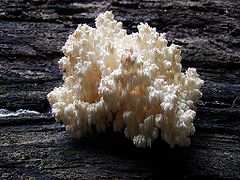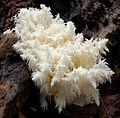Hericium
| Hericium | |
|---|---|

| |
| Hericium coralloides | |
| Scientific classification | |
| Kingdom: | Fungi
|
| Division: | |
| Class: | |
| Order: | |
| Family: | |
| Genus: | Hericium Pers. (1794)
|
| Type species | |
| Hericium coralloides (Scop.) Pers. (1794)
| |
| Species | |
|
See text. | |

Hericium is a genus of edible mushrooms in the family Hericiaceae. Species in this genus are white and fleshy and grow on dead or dying wood; fruiting bodies resemble a mass of fragile icicle-like spines that are suspended from either a branched supporting framework or from a tough, unbranched cushion of tissue. This distinctive structure has earned Hericium species a variety of common names—monkey's head, lion's mane, and bear's head are examples. Taxonomically, this genus was previously placed within the order Aphyllophorales, but recent molecular studies now place it in the Russulales.
Etymology[]
Hericium means hedgehog in Latin.[1] See Wiktionary entries Hericium and ericius.

History[]
The genus Hericium was originally described by Christian Hendrik Persoon in 1794. It was mentioned by Elias Magnus Fries in the Systema Mycologicum (1822); Fries considered it to be synonymous with the tribe Merisma of the genus Hydnum. In 1825 he recognized Hericium as a distinct genus, although not in the same sense as the genus would be known later.[2] It is native to North America.
Phylogenetics[]
In 2004, the phylogenetic relationships of Hericium species were analysed by comparing the rDNA internal transcribed spacer sequences of H. abietis, H. alpestre, H. americanum, H. coralloides, H. erinaceum, H. erinaceus and H. laciniatum. This analysis separated H. erinaceum from the six other Hericium species, and showed that H. erinaceus, H. abietis, H. americanum, and H. coralloides are closely related each to other but genetically diverged from H. alpestre and H. laciniatum.[3] Molecular genetic markers have been developed that allow for quick and sensitive identification of Hericium species using the polymerase chain reaction.[4]
The family Hericiaceae, to which Hericium belongs, belongs to the russuloid clade of basidiomycetes, making it phylogenetically related to the Auriscalpiaceae, the Bondarzewiaceae, and the Echinodontiaceae.[5][6]
Description[]
The fruit bodies typically have short stalks and are attached laterally to the host tree. Mature specimens are easily identified by drooping spines which hang down; the spines may be arranged in clusters or more usually, in rows. Positive identification of immature specimens can be more difficult as they often begin as a single clump, developing their branches as they age. They have no caps and contain spiny amyloid spores and numerous gloeopleurous hyphae filled with oil droplets.[7][8] The spores are spherical to ellipsoid, smooth or covered with very fine warts.[9]
Distribution and habitat[]
Hericium species are found extensively in the northern parts of the world, including North America, Europe, and Asia, often growing on old, fallen logs in dark and shaded areas of deciduous and Alpine forests.[10]
Uses[]
Hericium species are commonly found and consumed in North America and China.[citation needed] The species is readily cultivated.[10] Hericium is used in the folk medicine of China and Japan,[11] but there is no high-quality clinical research as of 2020 to indicate that it has any medicinal or biological properties. The genus Hericium produces the phytochemicals, erinacines and hericenones, which are cyathane metabolites under basic research.[12]
Species[]
| Image | Scientific name | Description | Distribution |
|---|---|---|---|
 |
Hericium abietis | Found on dead wood of conifers, especially fir and Douglas fir. | North America |
 |
A European species, confirmed—using sexual incompatibility studies—to be a distinct species from H. coralloides in 1983. Found in montane areas, typically on newly fallen trunks and stumps of Fir (Abies species). Spores are 5–6.5 by 4.5–5.5 µm.[13][14] | Slovenia | |
 |
Hericium americanum ("Bear's-head tooth") | solitary or clustered on dead or living deciduous wood, rarely on conifers | east of the Great Plains |
| [15] | Sikkim Himalaya (India) | ||
| Found growing on Quercus myrsinifolia | Sapporo,Japan | ||
 |
Hericium cirrhatum ("Spine-face") | This species' fruiting body is branched, with shell-shaped caps.[16] | southern England |
 |
Europe | ||
 |
Hericium coralloides ("Comb tooth"; "coral spine fungus") | Found on Beech (Fagus sylvatica) and Fir. Spores have dimensions of 3.5–5 by 3–4 µm.[13] | Widely distributed in Europe |
 |
Hericium erinaceus ("Bearded tooth", "Tree hedgehog", "Monkeyhead") | Found on living oak and beech trees.[13] | North America, Europe and Asia |
| Argentina[17] | |||
| [18] | small rooting base, intricate three tier branching system, 8-13mm long spines | India: Sikkim |
References[]
- ^ Spore Print Archived 2011-10-09 at the Wayback Machine, Quarterly Newsletter of the Edmonton Mycological Society
- ^ Miller LW. (1933). "The genera of Hydnaceae". Mycologia. 25 (4): 286–302. doi:10.2307/3754097. JSTOR 3754097.
- ^ Park HK, Ko HG, Kim SH, Park WM (2004). "Molecular identification of Asian isolates of medicinal mushroom Hericium erinaceum by phylogenetic analysis of nuclear ITS rDNA". Journal of Microbial Biotechnology. 14: 816–21.
- ^ Lu L, Li J, Cang Y (2002). "PCR-based sensitive detection of medicinal fungi Hericium species from ribosomal internal transcribed spacer (ITS) sequences". Biological & Pharmaceutical Bulletin. 25 (8): 975–80. doi:10.1248/bpb.25.975. PMID 12186429.
- ^ Larsson E, Larsson KH (2003). "Phylogenetic relationships of russuloid basidiomycetes with emphasis on aphyllophoralean taxa". Mycologia. 95 (6): 1035–65. doi:10.2307/3761912. JSTOR 3761912. PMID 21149013.
- ^ Miller SL, Larsson E, Larsson KE, Verbeken A, Nuytinck J (2006). "Perspectives in the new Russulales". Mycologia. 98 (6): 960–70. doi:10.3852/mycologia.98.6.960. PMID 17486972.
- ^ Volk T. "Hericium americanum, the pom pon mushroom, a.k.a. Lion's mane, the bear's head tooth fungus, monkey head, or for this month, the icicle mushroom". Fungus of the Month for January 2003. Retrieved 2009-06-27.
- ^ Kuo M. "The Genus Hericium (MushroomExpert.Com)". Retrieved 2009-06-27.
- ^ Ellis JB, Ellis MB (1990). Fungi without Gills (Hymenomycetes and Gasteromycetes): an Identification Handbook. London, UK: Chapman and Hall. pp. 102–3. ISBN 978-0-412-36970-4.
- ^ Jump up to: a b "Best Edible Wild Mushrooms - AmericanMushrooms.com". Retrieved 2009-06-27.
- ^ Cannon PF, Kirk PM (2007). Fungal Families of the World. Wallingford, UK: CABI. p. 158. ISBN 978-0-85199-827-5.
- ^ Bing-Ji Ma, Jin-Wen Shen, Hai-You Yu, Yuan Ruan, Ting-Ting Wu, Xu Zhao (2010). "Hericenones and erinacines: stimulators of nerve growth factor (NGF) biosynthesis in Hericium erinaceus". Mycology. 1 (2): 92–8. doi:10.1080/21501201003735556.CS1 maint: uses authors parameter (link)
- ^ Jump up to: a b c Hallenberg N. (1983). "Hericium coralloides and H. alpestre (Basidiomycetes) in Europe". Mycotaxon. 18 (1): 181–89.
- ^ Kiyashko AA; Zmitrovich IV (2013). "Hericium alpestre Pers" (PDF). Red Book of Karachaevo-Cherkessia: 212.
- ^ Das K; Stalpers J; Eberhardt U (2011). "A new species of Hericium from Sikkim Himalaya (India)". Cryptogamie Mycologie. 32 (3): 285–93. doi:10.7872/crym.v32.iss3.2011.285.
- ^ Pegler DN., D.N. (2003). "Useful fungi of the world: the monkey head fungus". Mycologist. 17 (3): 120–21. doi:10.1017/S0269915X03003069.
- ^ Hallenberg N; Nilsson RH; Robledo G (2012). "Species complexes in Hericium (Russulales, Agaricomycota) and a new species - Hericium rajchenbergii - from southern South America". Mycological Progress. 12 (2): 413–20. doi:10.1007/s11557-012-0848-4.
- ^ Das K; Stalpers JA; Stielow JB (2014). "Two new species of hydnoid-fungi from India". IMA Fungus. 4 (2): 359–69. doi:10.5598/imafungus.2013.04.02.15. PMC 3905948. PMID 24563842.

Further reading[]
- Ginns, J. (1985). Hericium in North America: cultural characteristics and mating behavior. Canadian Journal of Botany 63: 1551–1563.
- Harrison, K. A. (1973). The genus Hericium in North America. Michigan Botanist 12: 177–194.
- Russulales
- Russulales genera